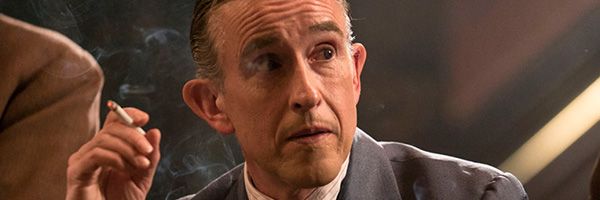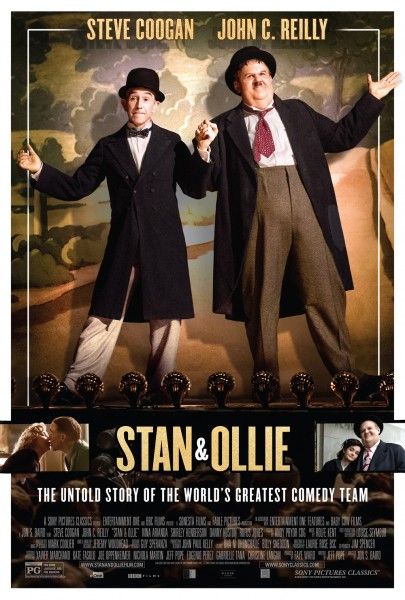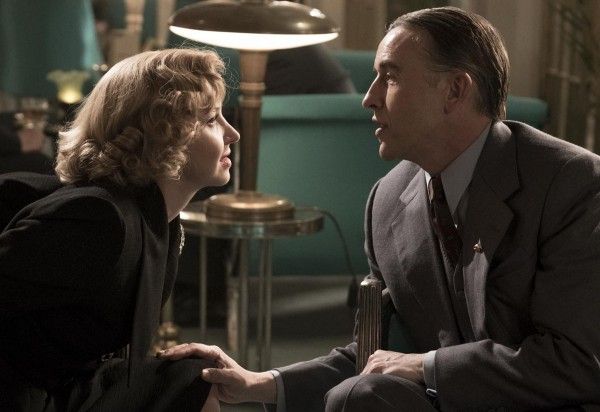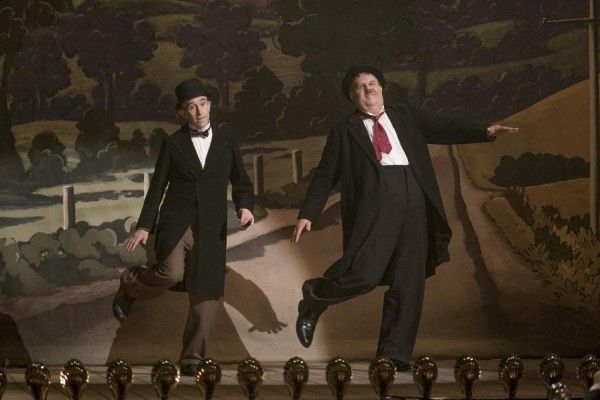From director Jon S. Baird and screenwriter Jeff Pope, the biographical dramedy Stan & Ollie follows the great comedy team of Stan Laurel (Steve Coogan) and Oliver Hardy (John C. Reilly), as they set out on a variety hall tour of Britain in 1953. With their golden era behind them and an uncertain future, the two funnymen quickly reconnect with their adoring fans and the tour becomes a hit, but that doesn’t dissolve the tension between them or cure Oliver’s failing health, leaving the two men wondering just how much they mean to each other.
During this 1-on-1 phone interview with Collider, actor Steve Coogan talked about what made him want to play Stan Laurel, what he was nervous about when it came to taking on such a comedy legend, the challenges of making the Laurel & Hardy comedy routines look so effortless, what he learned about John C. Reilly from working so closely with him, his personal favorite moment in the film, his new appreciation for the comedy duo, getting into the costumes and prosthetics, and reuniting with his co-star for an appearance in Holmes & Watson.
Collider: I loved this film and thought it was such a beautifully told story. You and John C. Reilly were both so terrific in it, and I really loved the women, as well.
STEVE COOGAN: It’s good that the women’s roles are not just loyal wife, boring roles.
What made you want to play Stan Laurel?
COOGAN: I had written with Jeff Pope before. I wrote a film called Philomena with Jeff, and it was at the Oscars five years ago. Jeff and I had been writing lots of stuff, in between that. He was my writing partner, but he had written this by himself. He said, “Would you be interested in playing Stan?,” and I heard that John C. Reilly was in the offering for Oliver. So, I thought, if John C. Reilly agreed, then I would be in. To me, a green light for me doing it would be if John agreed to it. And then, Jon S. Baird, the director, came and met me, talked to me, and had to decide whether he wanted me. I just started talking like Stan and doing an impersonation. Really, I just didn’t want anyone else to do it, although it was a bit of a responsibility. Also, anything you do, if you do interesting stuff, you’ve got to carry the risk of failure. Otherwise, you just play safe, all the time. If you’re creative, you can get very bored, very quickly, so you need to roll the dice, and I thought this was worthwhile.
Were there specific aspects of playing him or embodying him that made you nervous, or was it just the idea of doing it, at all?
COOGAN: I could do an impersonation of him, but I didn’t want the role to be a superficial facsimile of who Stan was. I wanted to do him justice. I wanted to make sure that John and I were well-matched in what we were doing, and that we built up a trust and a friendship to help us with the roles. I was anxious about it not having depth. Impersonating someone is quite useful sometimes, but it can be fraught with danger and only skin deep. I was anxious about that, and wanted to make sure that wasn’t the case. The other thing was the physicality, but I knew that if I put the work in, I could get that right. There’s a great clown advisor, called Toby Sedgwick, who taught us tips on how to move, gestures, physicality, and dancing. Once we were off to the races, we knuckled down and I thought it was doable, especially with John. When you’ve got a good partner, then you’ve got a job halved.
The comedy routines of Laurel & Hardy were hilarious and seemed effortless, while they clearly were meticulously worked on and thought out. What were the challenges of making that look easy and effortless on film?
COOGAN: It’s a skill, and you’re trying to emulate their skill. When they made their films, Stan was the brains behind the operation. Oliver did make a contribution, but Stan wrote most of them and directed a number of them. They had to make it look effortless. It’s very hard, especially when you’re doing a dance routine. You have to learn it, and then slightly unlearn it. You have to throw it away a bit. You have to learn it mathematically and musically, with discipline, and then you need to make it a little more ragged. The skill and the hard work is making it look effortless. When it just looks accidental, that’s through rehearsal. You rehearse, and rehearse, and rehearse. We actually had nearly a month, before the film started, where we had to do dance routines, and practiced gestures and physicality. We’d all talk to each other. Every day, we dressed up. We got to know each other and got to know the characters a bit. The way we rehearsed the dances, in some ways, was exactly the way Laurel and Hardy would have rehearsed the sketches and the dance routines.
It seems like you couldn’t help but know each other so much better, by the end of this, than you would have, in the beginning. By the time you got to the end of the film, what new appreciation did you have for John C. Reilly? What did you learn about him, as an actor, through this experience?
COOGAN: I got to know him because we were working closely and we were co-dependent. It was a partnership. We were a team, and we had Jon S. Baird guiding us. John and me inevitably became friendly and close. What I learned from watching him is that he’s fastidious about his job. John is all about the work, with no star BS behavior. He’s always about making it authentic and real. He would call things out sometimes, when they weren’t quite believable. A couple of scenes were re-shot because they didn’t quite ring true. He’s committed, very professional, and also good fun. We made each other laugh. It was an utter delight.
There are a lot of physical moments in this, a lot of funny moments, and quite a few emotional moments. When it came to exploring that friendship between Stan and Ollie, is there a scene or a moment that was a personal favorite for you?
COOGAN: My favorite scene is in the montage at the end, when we had the double-door routine. The music is playing and there’s a moment where I’m behind the scenes with Oliver and we’re not even saying anything. The music is swelling, and I look to him and count down from three, with my fingers in front of him, to tell him when we need to walk back through the door again. I love the fact that it shows the hard work that goes on behind comedy. You see some of the craft. We see the silliness on the other side of the wall – or the audience does – but what the film does is shows you behind the scenes. That moment is really poignant because it’s a technical thing of counting down with his fingers to say, “Now, we must go through the door to get maximum comic effect.” That part of it feels like a love letter to comedy, to the commitment, and to the expertise of the people that perform it so well.
Did making this film change your impression or appreciation for Laurel and Hardy?
COOGAN: Yes, I think it did. I’ve worked in comedy and I know that it’s no cake-walk. I did watch Laurel & Hardy on TV, on reruns, as a kid, and I would just laugh at two silly guys, like everyone else. But then, when you start to rehearse these things and you see the timing, you realize that the more random and accidental the comedy seems, that’s the test of the sheer hard work that’s gone into it. They rehearsed every moment, every look and every scratch of the head, and you have to appreciate that.
Obviously, you didn’t have to go through as big of a visual change to play Stan Laurel, as John C. Reilly had to go through to play Oliver Hardy, but there were some things that were done.
COOGAN: I had a false chin and two false tips to my ears. With John, from the nose down is not his, and he had this huge fat suit.
What was it like to see yourself in the clothes, with those little changes? Did you feel different, seeing yourself that way?
COOGAN: The clothes and everything certainly does make you feel different. It definitely helps. John and I would look in the mirror and think, “Well, we’re not John and Steve anymore. We’re Stan and Ollie.” You see someone else staring back, and you go for it.
You must have enjoyed working with John C. Reilly, since you’re also in Holmes & Watson with him. What was that experience like and who are you playing in that?
COOGAN: I play an invented Victorian tattoo artist. I only did two days on it. It’s John and Will Ferrell, and that old partnership. I just did a couple of days on it, to play a steampunk tattoo artist who meets a grizzly end. It was a lot of fun. It was great ‘cause I’ve worked with Will before, so it was nice to do that again.
Stan & Ollie opens in theaters on December 28th.




